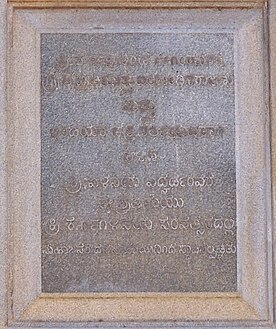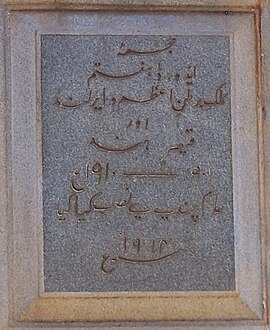
The British farthing historically abbreviated qua., was a denomination of sterling coinage worth 1/960 of one pound, 1/48 of one shilling, or 1/4 of one penny. It was minted in copper and later in bronze, and replaced the earlier English farthings.

Vidhana Soudha in Bangalore, India, is the seat of the state legislature of Karnataka. It is constructed in a style described as Neo-Dravidian, and incorporates elements of various Dravidian styles. Construction was started in 1952 and completed in 1956.

The Delhi Durbar was an Indian imperial-style mass assembly organized by the British at Coronation Park, Delhi, India, to mark the succession of an Emperor or Empress of India. Also known as the Imperial Durbar, it was held three times, in 1877, 1903, and 1911, at the height of the British Empire. The 1911 Durbar was the only one that a sovereign, George V, attended. The term was derived from the common Persian term durbar.

A garland is a decorative braid, knot or wreath of flowers, leaves, or other material. Garlands can be worn on the head or around the neck, hung on an inanimate object, or laid in a place of cultural or religious importance.
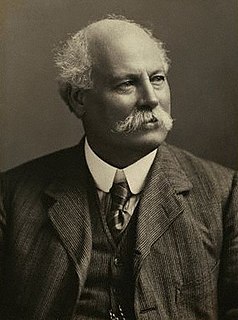
Sir Thomas Brock was an English sculptor and medallist, notable for the creation of several large public sculptures and monuments in Britain and abroad in the late nineteenth and early twentieth centuries. His most famous work is the Victoria Memorial in front of Buckingham Palace, London. Other commissions included the redesign of the effigy of Queen Victoria on British coinage, the massive bronze equestrian statue of Edward, the Black Prince, in City Square, Leeds and the completion of the statue of Prince Albert on the Albert Memorial.

Sir George James Frampton, was a British sculptor. He was a leading member of the New Sculpture movement in his early career when he created sculptures with elements of Art Nouveau and Symbolism, often combining different materials such as marble and bronze in a single piece. While his later works were more traditional in style, Frampton had a prolific career in which he created many notable public monuments, including several statues of Queen Victoria and later, after World War I, a number of war memorials. These included the Edith Cavell Memorial in London, which, along with the Peter Pan statue in Kensington Gardens are possibly Frampton's best known works.
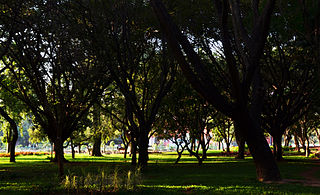
Cubbon Park, officially known as Sri Chamarajendra Park, is a landmark 'lung' area of Bengaluru city, located within the heart of the city in the Central Administrative Area. Originally created in 1870 under Major General Richard Sankey, then British Chief Engineer of Mysore State, it covered an area of 100 acres (0.40 km2). Subsequent expansion has since taken place and the park's area is now reported to be 300 acres (1.2 km2). It has a rich recorded history of abundant flora and fauna plantations coupled with numerous impressive and aesthetically located buildings and statues of famous personages, in its precincts.

Sir Edgar Bertram Mackennal, usually known as Bertram Mackennal, was an Australian sculptor and medallist, most famous for designing the coinage and stamps bearing the likeness of George V. He signed his work "BM".

Coronation Park is a park located on Burari Road near Nirankari Sarovar in Delhi, India. The park is sometimes referred to as the Coronation Memorial; it was the venue of the Delhi Durbar of 1877 when Queen Victoria was proclaimed the Empress of India. Later it was used to celebrate the accession of King Edward VII in 1903, and, finally, it was here that the Durbar commemorating the coronation of King George V as Emperor of India took place on 12 December 1911, subsequent to his coronation at Westminster Abbey in June 1911. This last celebration had all the princely states in attendance. The decision to hold the Coronation Durbars in Delhi at the vast open ground at Coronation Park was a move to emphasise the historical significance of Delhi as the former capital of the Mughal Empire.

King Edward VII of the United Kingdom has been depicted a number of times in different media and popular culture.
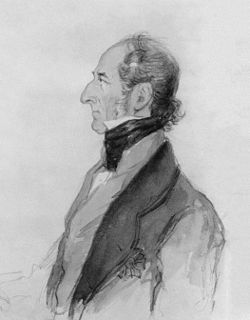
Lieutenant-General Sir Mark Cubbon KCB was a British army officer with the East India Company who became the British Commissioner of Mysore state in 1834. During his tenure, he established a law and order system, introduced judicial and economic reforms and through action in all spheres of governance helped develop the economy of Mysore. He resigned from his office in 1860 due to ill-health and left for England for the first time since his arrival in India as a cadet in 1800. The administration of the Kingdom of Mysore under his leadership ensured that the 1857 rebellion had almost no impact in the region. He died in 1861 on board ship at Suez. Cubbon Road and Cubbon Park in Bangalore are named after him.

The Victoria Memorial is a large marble building on the Maidan in Central Kolkata, built between 1906 and 1921. It is dedicated to the memory of Queen Victoria, Empress of India from 1876 to 1901.

Cubbon Park is a station on the Purple Line of the Namma Metro in Bangalore, India. It was opened to the public on 30 April 2016. The station is located a few metres away from one of the entrances to Cubbon Park.

Government Museum, Bangalore, established in 1865 by the Mysore State with the guidance of Surgeon Edward Balfour who founded the museum in Madras and supported by the Chief Commissioner of Mysore, L.B. Bowring, is one of the oldest museums in India and the second oldest museum in South India. It is now an archaeological museum and has a rare collection of archaeological and geological artifacts including old jewellery, sculpture, coins and inscriptions. The museum is also home to the Halmidi inscription, the earliest Kannada inscription.

Sankighatta, The name comes from Settra + Ghatta = Settraghatta and is pronounced as Sankighatta. In Kannada language Settra + Ghatta (Place) literal meaning is ""place of Settru"". Dallina Vardaman Mahaveera Thirtankara is the Lord Mahaveer Swamy Jain Basadi/temple in Karnataka, south India. Sankighatta was a historic Jain center and was under the control of Settru family, the Samantha Rajas. They also controlled surrounding places like Kalya, Kunigal, Magadi, Savandurga, Hebbur, Mayasandra, Settikere, Veerasagara, Srigiripura, Shivaganga hills, Biskuru, etc..

The Statue of Edward VII stands in Kings's Gardens, Stanley Road, Bootle, Sefton, Merseyside, England. It was erected to commemorate the Coronation of King Edward VII and consists of a bronze statue of Edward VII on a granite pedestal. The sculptor was George Wade. The statue was given to the borough by the local Member of Parliament, and stands on land given to the borough by Lord Derby. It was unveiled by Lady Derby in 1904.
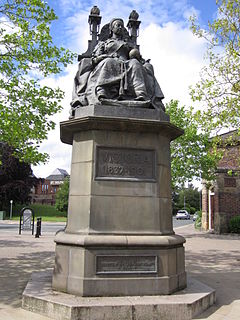
The Statue of Queen Victoria stands on the western side of Victoria Square, St Helens, Merseyside, England. It was created after the death of Queen Victoria and given to the town by Colonel William Windle Pilkington, mayor of St Helens in 1902, and a member of the Pilkington glass manufacturers in the town. ilkington commissioned George Frampton to design it. Frampton used the same model for the figure of the queen for two other statues, but placed it on thrones and pedestals of different designs. The St Helens statue was unveiled by the Earl of Derby in 1905. Originally placed in the centre of Victoria Square, it was moved to a position on the west side of the square in 2000. The statue is recorded in the National Heritage List for England as a designated Grade II* listed building.
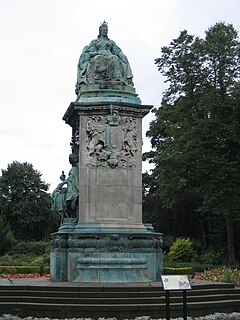
A Memorial to Queen Victoria stands in Woodhouse Moor, Leeds, West Yorkshire, England.

The Statue of Queen Victoria, Bangalore, is located at Queen's Park, next to Cubbon Park, Bangalore Cantonment, at the junction of 3 roads, at the border between the Cantonment and the Bangalore Pete. The statue was unveiled on 5 February 1906 by the then Prince of Wales, George Frederick Ernest Albert. The statue was raised out of funds raised by the residents of the Bangalore Civil and Military Station and contributions made by Krishna Raja Wadiyar IV, the Maharaja of Mysore. This Statue of Queen Victoria is one of the five of the original 50 statues of Queen Victoria which were installed in British India, to still stand at its original location. The statue has blossoms of jacaranda falling around. On the other end of Queen's Park is the Statue of King Edward VII.

A bronze statue of William III of England stands on the south side of Kensington Palace in London, facing towards the Golden Gates. The statue was designed by Heinrich Baucke and erected in 1907. It was cast by the Gladenbeck foundry in Berlin and given as a gift by the German Emperor Wilhelm II to his uncle, King Edward VII. The statue has been a Grade II listed building since 1969.







